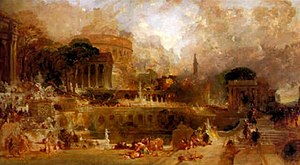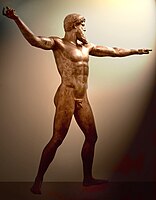Battle of Corinth (146 BC)
| Battle of Corinth | |||||||||
|---|---|---|---|---|---|---|---|---|---|
| Part of the Achaean War | |||||||||
 The last day of Corinth, Tony Robert-Fleury, 1870 | |||||||||
| |||||||||
| Belligerents | |||||||||
| Roman Republic | Achaean League | ||||||||
| Commanders and leaders | |||||||||
| Lucius Mummius | Diaeus † | ||||||||
| Strength | |||||||||
|
23,500 infantry 3,300 cavalry |
13,500 infantry 650 cavalry | ||||||||
| Casualties and losses | |||||||||
| Minor | Total | ||||||||
The Battle of Corinth of 146 BC, also known as the Battle of Leucapetra or the Battle of Lefkopetra, was a decisive engagement fought between the
The Romans had moved swiftly since the war's beginning a few weeks earlier; they had destroyed the main Achaean force at Scarpheia, conquered Boeotia and then proceeded to Corinth itself. Despite the Roman successes, the Achaeans refused to surrender and gathered a final army for the defense of the League's capital of Corinth, where they engaged the Romans in battle. In a few hours of fighting, the Achaeans were soundly routed, with their troops killed, captured, or put to flight. After a few days' waiting, the Romans entered the city, and, on the orders of Mummius, set it on fire, killed all the men and enslaved all the women and children, after which the rest of Greece was subjugated by Rome.[citation needed]
Background
Tensions between Rome and Achaea had been building up for a few decades prior to the conflict that is now known as the Achaean War, but tensions came to a head in 148-146 BC, over Achaean desires to assimilate the
Prelude
Marching from
In 146 BC, Lucius Mummius arrived, sent Metellus back to Macedonia and gathered all Roman forces in the region, amounting to 23,000 infantry and 3,500 cavalry (probably two legions plus Italian allies), as well as
Battle
The Romans had posted some Italian auxiliaries as lookouts, but they were careless in their watch, possibly on account of hubris at the comparatively smaller Achaean army.[9] This allowed the Achaeans to make a successful night attack on the camp of the Roman advance guard, inflicting significant casualties and bolstering Achaean morale. Mummius then sallied out himself, routing the pursuers and driving them back to the Achaean camp.[10]
Encouraged by their early successes, the Achaeans offered battle the next day. In the ensuing battle, the infantry stood the charge of the legions, but the Achaean cavalry, heavily outnumbered, did not wait to receive the Roman cavalry charge and instead rapidly dispersed.
Sack of Corinth
Demoralized at their leader's flight, the surviving Achaean troops and most Corinthians fled the city, but the Romans, fearing an ambush, did not enter Corinth until three days after the battle. Once in Corinth, the Romans killed all men and enslaved the women and the children, after which the city was sacked and utterly destroyed by the victorious Roman army and saw all of her treasures and art plundered. According to Polybius, Mummius was unable to resist the pressure of those around him.[13][14] Livy writes that Mummius did not appropriate any of the spoils for himself, and praises him for his integrity.[15] The annihilation of Corinth, the same fate met by Carthage the same year, marked a severe departure from previous Roman policy in Greece.
Polybius mentions the carelessness of Roman soldiers, who destroyed works of art or treated them like objects of entertainment.
Aftermath
The battle marked the end of Achaean resistance; Greece would not see fighting again until the First Mithridatic War sixty years later. The League was dissolved, Greece was annexed to the newly-created province of Macedonia (though some autonomy was given to certain cities) and direct Roman control over mainland Greece was established.[20]
The city of Corinth did not recover for over a century. While there is archaeological evidence of some minimal habitation in the years afterwards, it was only when Julius Caesar re-established the city as Colonia Laus Iulia Corinthiensis in 44 BC, shortly before his assassination, that the city began to experience some of its old prosperity once again.[21]
Gallery
-
The Sack of Corinth, by Thomas Allom
-
The Jockey of Artemision, which may have been taken from Corinth in the looting of the city by Mummius
-
Roman general Lucius Mummius Achaicus in The Sack of Corinth, by Thomas Allom (detail)
-
The Destruction of Corinth, by Thomas Allom
-
The Artemision Bronze, another bronze which may have been taken from Corinth
In popular culture
- The Battle of Corinth was the central event in the 1961 film The Centurion.
References
- ^ Cassius Dio XXI.72
- ^ Polybius 38.9
- ^ Gruen 1976, p. 69.
- ^ Gruen 1976, p. 66.
- ^ Dio, XXI.72
- ^ Polybius, 39.8
- ^ Gruen 1976, p. 67.
- ^ Pausanias, 7.16
- ^ Pausanias, 7.16
- ^ Dio, XXI.72
- ^ Pausanias, 7.16
- ^ Pausanias, 7.16
- ^ Chisholm 1911.
- ^ Dillon & Garland 2005, p. 267.
- ^ Livy, Periochae 52.6
- ^ Polybius, 39.13
- ^ Polybius, 39.14
- ^ Paterculus, 1.13
- ^ Henrichs 1995, pp. 254–255.
- ^ Pausanias, 7.16
- ^ Dio, XXI.72
Sources
Primary sources
- Cassius Dio, Roman History, Book 21
- Velleius Paterculus, Roman history, Book I
- Ab Urbe Condita Libri, Book XLV and Periochae 46-50
- Polybius, The Histories, Books 38 and 39
- Pausanias, Description of Greece, Book 7
Secondary sources
- Gruen, Erich S. (1976). "The Origins of the Achaean War". The Journal of Hellenic Studies. 96: 46–69. S2CID 162729635.
- Henrichs, Albert (1995). "Graecia Capta: Roman Views of Greek Culture". Harvard Studies in Classical Philology. 97: 243–261. JSTOR 311309.
- Dillon, Matthew; Garland, Lynda (2005). Ancient Rome: From the Early Republic to the Assassination of Julius Caesar. Taylor & Francis. pp. 267–. ISBN 978-0-415-22458-1.
Attribution
- This article incorporates text from a publication now in the public domain: Chisholm, Hugh, ed. (1911). "Mummius, Lucius". Encyclopædia Britannica. Vol. 18 (11th ed.). Cambridge University Press. pp. 966–967.





